#asahi shimbun publications
Text
Big Vampire Hunter D News!
Through the Facebook fan group I'm in, I learned that the VHD manga is finally continuing after a 10 year hiatus.
That's right, it's not a dream, the manga is back! This time in webcomic form, with chapters being released bi-monthly, on the 15th and 30th of each month.
For now, the manga is only in Japanese, and can be read on Asahi Shimbun Publication's official website, Sonorama+.
The manga is furthering D's story right now with volume 9, The Rose Princess.
With help from google translate, I've read the chapters currently posted. I'm so happy. The Rose Princess is one of my top fav books, and I'm beyond excited to see the rest.
66 notes
·
View notes
Text

On July 31, Asahi Shimbun Publishing announced that #SaikoTakaki will adapt "The Rose Princess," the ninth novel in Hideyuki Kikuchi and Yoshitaka Amano's #VampireHunterD series, into a #Manga.
The manga will be serialized on Asahi Shimbun's Sonoroma+ website, with updates scheduled for the 15th and 30th of each month. The series is set in the post-apocalyptic year 12,090 A.D. and explores humanity's struggle against the vampire race known as the Nobility.
The original novels began publication in Japan in 2005 and inspired the 1985 OAV "Vampire Hunter D" and the 2000 film "Vampire Hunter D: Bloodlust.
31 notes
·
View notes
Text
wip wednesday, or, as i like to call it, thursday
sharing some of the most recent project i've been tinkering with which is the omusubi/season 3 essay:
On May 1, 2019, a new emperor takes the Chrysanthemum Throne. The Heisei era died in April, with imperial year Reiwa 1 beginning the day after Akihito abdicated. No emperor has voluntarily relinquished himself of his role in over 200 years, apparently so unprecedented that the Imperial Household Law of 1947 - which dictates plans of succession - had no legislation covering this situation.
令和 (Reiwa) is unique in that it’s the only era name that comes from Japanese originated text as opposed to the tradition of using classical Chinese texts, something prime minister Shinzo Abe publicly emphasized. 令和 is officially read as "beautiful harmony." As you can imagine, people disagree over this interpretation. Taken from the Asahi Shimbun:
However, some experts said the first Chinese character, 令 (Rei), today is most widely thought to mean "order," ”command," and "dictate," with an authoritarian tone.
Historians and experts on the monarchy noted that an 1864 era name proposal of "Reitoku" using the same first character was rejected by the Tokugawa Shogunate, which said it sounded like the emperor was commanding Tokugawa.
"The name sounds as if we are ordered to achieve peace, rather than doing so proactively," Kazuto Hongo, a University of Tokyo historian, said on TV Asahi.
Yoshinori Kobayashi, a conservative cartoonist who has written books on Japanese emperors, said the character "Rei" portrays "the people kneeling down under the crown. Its meaning, after all, is a command of a monarch or a ruler. ... It is inevitable that 'Reiwa' gives a somewhat cold impression." [x]





Circling back around, one of the morals in S3E1 is: if you're going to be an asshole in public, then there's going to be public consequences. When there's no consequences, the assholes won't ever go away. Sticking a pin in this idea for later, what if that's sometimes a good thing?

Why are the sextuplets assholes? While we could list off answers forever, they all ultimately boil down to why (in part) the sextuplets are also virgin NEETs. Unabashedly, they're terrible people. And remember, nothing is sacred. The fact they're Not in Education, Employment, or Training, is a huge part of promoting the characters in such a manner. I don’t think I need to explain why this is clearly a dig at how such a capitalistic society values your productivity - both as a consumer and as an employee - and the fact that the conceptual NEET who engages in playtime isn’t the worst person to be. So, if this is a gag comedy anime that relies on relatability - on an audience that’s to, on some level, sympathize with these guys, what about this NEETdom is relatable?
8 notes
·
View notes
Text

Weekly Manga Sekai no Ijin (週刊マンガ世界の偉人) / Asahi Shimbun Publications (朝日新聞出版) / 27th May 2012 issue (Featured historical figure: Galileo Galilei)
#educational manga#galileo galilei#galileo#2010s manga#asahi shimbun#issue month: may#週刊マンガ世界の偉人#朝日新聞出版
11 notes
·
View notes
Text
コストコ予定地で「遺構を一般公開せず埋めた」報道 市教委「法律違反かの印象与える記事は心外」...朝日新聞の見解は
-


Report on 'remains buried without public access' at planned Costco site, City Board of Education: 'It is disturbing to read an article that gives the impression that it is against the law…'… What is the Asahi Shimbun's view?
18 notes
·
View notes
Photo

Inside the main structure of Shakuzen’in Hall (積善院) at Shōgo’in Temple (聖護院) in Kyoto, headquarters for Tendai-based Honzan Shugendō mountain asceticism, enshrining here an assemblage of images from former buildings of the temple that lapsed into disuse when Shugendō was abolished by the government 1872-1946
In front is a sculpted image of the wrathful deity Fudō Myōō (不動明王) dating to the 12th century flanked by two dragon kings (竜王), while behind is a sculpted image of Juntei Kannon Bodhisattva (准胝観音菩薩) dating to the early 19th century
Photo by Satō Yoshiko (佐藤慈子) from an April 17, 2019 Asahi Shimbun Article covering a rare public viewing of these images
#japanese art#buddhist art#不動明王#fudo myoo#竜王#ryuo#准胝観音菩薩#准胝観音#juntei kannon#jundei kannon#観音菩薩#観音#kannon#avalokitesvara#京都#kyoto#聖護院#shogoin#積善院#shakuzenin#天台宗#tendai#修験道#shugendo#本山修験宗#honzan shugen#japanese religion
87 notes
·
View notes
Text
Japan removes monument for Korean forced labor victims despite criticism
By Yi Wonju
TOKYO, Feb. 1 (Yonhap) -- A Japanese local government has taken down a memorial stone for Korean victims of Japan's wartime forced labor at a public park earlier this week despite opposition from activist groups.
Authorities from Gunma Prefecture began pulling down the stone on Monday and finalized the removal on Wednesday, Japan's Asahi Shimbun newspaper reported the next day.
Aerial photographs taken by the news outlet showed the remains of what appeared to the base of the memorial stone smashed into pieces at the site.
The authorities are said to have spared the epitaph of the stone and handed it over to a civic group handling the memorial stone, before tearing down the concrete wall.
The phrase, "Remembrance, Reflection and Friendship," is engraved in Korean, Japanese and English on the epitaph.
The memorial stone was erected in 2004 by a civic group in Japan to promote the public's understanding of the shared past history from Japan's 1910-45 colonial rule of the Korean Peninsula and the friendship between the two neighbors.
In 2014, Gunma Prefecture refused to extend the state approval for the establishment of the stone, claiming a civic activist made inappropriate remarks about the forced labor victims during a 2012 memorial event.
Japan's top court ruled in favor of the Gunma authorities in 2022, but the civic group has filed for separate suits seeking to block the removal.
Source: https://en.yna.co.kr/view/AEN20240201008400315
#japanese imperialism#news#japan#korean victims#korean#gunma prefecture#gunma#memorial#forced laborers
7 notes
·
View notes
Text
Lawyers urge court to dissolve Unification Church
THE ASAHI SHIMBUN
September 5, 2023 at 19:04 JST
Susumu Murakoshi, second from right, the head of the Lawyers from Across Japan for the Victims of the Unification Church, speaks at a news conference in Tokyo on Sept. 4. (Ryuichi Kitano)
Lawyers representing victims of the Unification Church called upon the government to disband the religious organization and urged a court to issue a dissolution order.
“The church has clearly been conducting illegal acts systematically and continuously, which meets the requirements for a dissolution order,” Susumu Murakoshi, the head of the Lawyers from Across Japan for the Victims of the Unification Church, said at a news conference on Sept. 4.
“We would like the government to promptly file the request and the court to issue the order,” he said.
The government is preparing to ask the Tokyo District Court to issue a dissolution order against the organization formally known as the Family Federation for World Peace and Unification.
Masaki Kito, the deputy head of the lawyers’ group, said that the church could try to evade asset seizure in preparation for a dissolution order.
“For the relief of victims, we hope that the government will make provisions to preserve the church’s assets as soon as possible,” he said.
The government has already exercised its right to ask questions and request reports on the church under the Religious Corporations Law.
The Unification Church, however, has failed to answer numerous questions related to its alleged shady business practices. So, the government plans to soon call on the district court to levy a fine against the church.
"If the fine is imposed, it would provide evidence of the church's legal violations and could strengthen the case to justify dissolving the church,” said Katsuomi Abe, the deputy secretary-general of the lawyers’ group.
At the news conference, the lawyers said that they had requested collective negotiations with the church on behalf of 15 victims.
They are seeking compensation for former church followers and their relatives, who say they were coerced into purchasing expensive items for, and making large donations to, the Unification Church.
This is the fifth time that the lawyers made such a request.
They said the church had not responded sincerely to the previous four requests, so they filed for mediation with the district court on July 31.
A public relations official for the Unification Church said that “we would like to refrain from commenting at this stage” about the potential fine and request for dissolution.
The church has come under fire since the murder of former Prime Minister Shinzo Abe in July 2022. The suspect told investigators that his mother's large donations to the church ruined his family financially and he blamed Abe for promoting the church.
#unification church#moonies#ffwpu#hak ja han#family federation for world peace and unification#exploitation
2 notes
·
View notes
Note
What happens in the bylines au?
OK OK SO
(preface: i don't know much about japanese journalism so a lot of this is gonna be framed through the lens of american journalism)
The background: during World War III, a lot of war crimes were exposed by journalists deep undercover in the military in order to circumvent increasing post-Vietnam restrictions on the movements of war correspondents. This resulted in an international wave of deep-undercover journalism, widening the scope of press tactics considered acceptable so that, in this universe, undercover reporters might have the responsibilities and training similar to an undercover government agent or police officer
Enter the investigative unit of The Asahi Shimbun. Reporters on this unit have their stories published under the same anonymous byline, and their identities aren't made public. (This is NOT how things work in real life, to be clear. I'm just pulling Asahi because they're Japan's most prestigious paper.) They have a general practice of always having a reporter undercover in the Japanese government. So they put rookie reporter Matsuda into the NPA — it's easy to do so with his dad's connections. They also plant one of the assistant editors, Ide. Their job is mostly to track down sources and notify other reporters of stories covered up by the Japanese police, not do their own reporting. But then the Kira case happens, and the Japanese police start chasing Kira with a skeleton crew. Matsuda stays on the Kira task force, and Ide leaves so he can keep an eye on the Kira investigation from the outside.
As they learn more and more about Kira, particularly that he needs a name and face, they're forced to grapple with issues of news ethics. How do you balance the public's right to know with the fact that you're putting a crosshairs on the people you name? When the Japanese police stops chasing Kira altogether, should they hold them accountable by running a story on that, or will doing so just put the task force at risk? If I ever wrote this into a full fic, I think it would be a really cool opportunity to discuss how news ethics and practices would change in the Death Note universe. For instance, a journalist should always put their name to what they do — that would probably change.
Takada is a TV journalist who tries to stay neutral, just reporting on the impact of Kira's killings. But she's torn. She sees firsthand both the fall in crime as a result of Kira and the grief his victims leave behind. She gets in contact with more pro-Kira circles and starts going undercover within them. In the end, she starts pretending to be pro-Kira while being determined to catch Kira if the cops won't. Imagine her surprise when Kira contacts her. With his name attached. And it's her ex.
But her word alone isn't enough. Not for a story like this, and she can't do this reporting by herself. So she gets in contact with two papers she knows have plants in Kira investigations: Asahi Shimbun and the Washington Post.
Gevanni is a photojournalist undercover in the FBI investigating corruption when he gets recruited to the SPK. Takada gets in contact with him and Matsuda.
Matsuda doesn't believe her at first. So of course he joins her. If something needs to be proven wrong, he wants to investigate.
I don't really have a concrete idea of what the plot would look like — that's the overall premise. Some more tidbits:
-Matsuda is trans, and him and Gevanni met in college when he was pre-transition. So he knows who Gevanni is when they meet, but Gevanni doesn't recognize him
-Matsuda and Ide are using aliases, I just refer to them by those aliases for clarity. So when Misa gets the shinigami eyes again, she and Light soon realize Matsuda isn't all he seems. Takada isn't using an alias, because she didn't start her career intending to do investigations. Gevanni also isn't, because that would require a fake ID, which is illegal, and he's a stickler for the SPJ code of ethics.
-as an irl journalist i dont condone ANY of this
-Does L know? Who knows. Probably about Matsuda, but not Ide. Depends on how much of a background check he does
-gevanni only uses pittman ruled notebooks and writes in shorthand. if he has to use gregg he will cry. he and i have that in common
-matsuda and gevanni kiss
6 notes
·
View notes
Text
Prime Minister Fumio Kishida said Wednesday he will not run in the ruling Liberal Democratic Party’s presidential election slated for September, guaranteeing that Japan will have a new prime minister after the LDP’s leadership race.
“The easiest way to clearly show that the LDP has changed is for me to step aside,” Kishida said at a news conference shortly after the news broke. “I won’t be running in the upcoming LDP presidential election.”
“The government won’t be able to push key policies forward unless there is sufficient trust in politics and politicians,” he said, explaining the reasoning behind his decision.
Kishida said he will support whoever is chosen as party president as a “rank-and-file member.”
But he refused to comment on who he would back in the race, simply saying that he hopes someone who is reform-minded will be elected.
Kishida cited the LDP’s political funds scandal as one of the reasons for stepping down, saying that, as party leader, he should take responsibility for what happened.
Since late last year, the LDP has been wrestling with the fallout of a slush funds scandal, which led to a majority of the party’s factions being dissolved. It also significantly hurt the party’s standing with the general public.
“As leader of the party, I have no hesitation in taking responsibility for what its members did,” Kishida said, adding that he has been thinking about stepping down since the scandal surfaced and was seeking the right timing to make the announcement.
The surprise move by Kishida, who has been at the helm since October 2021, came amid growing criticism from rank-and-file party members and bad poll numbers.
The Kishida administration and the LDP had faced mounting popular discontent for months, especially over the political funding scandal that rocked the party late last year.
A recent NHK poll put Kishida’s support rate at 25% in August, down from 29% in November, just before the political slush fund surfaced. In an Asahi Shimbun poll conducted in July, 74% of respondents said they didn’t want Kishida to stay in his position after September’s leadership election.
The announcement came in the middle of the Bon holiday period, when the political epicenter of Nagatacho largely empties out as lawmakers return to their home districts. It also came a week before an internal LDP election committee is slated to announce the date of the party’s leadership election.
Within the LDP, maneuvering is expected to intensify as it seeks to find a new leader, and likely potential candidates are already jockeying for position. They include LDP Secretary-General Toshimitsu Motegi, former Defense Minister Shigeru Ishiba and digital minister Taro Kono. Other possibilities include former Environment Minister Shinjiro Koizumi and economic security minister Sanae Takaichi.
In the news conference, Kishida expressed his hopes that a newly elected leader will build a “dream team” that can gain the “trust and empathy” of the people and tackle the challenges Japan is facing.
“I strongly hope that those who think they are the best to run the party will put up their hands and compete in a serious race,” Kishida said.
He went on to highlight his achievements, including his efforts to revive a sluggish economy, promote a substantial hike in defense and social security spending, boost nuclear energy and his diplomatic efforts that brought Japan closer to the United States and South Korea.
Recognizing that his own response to the slush funds scandal had received much criticism, he used the occasion to reiterate his full commitment to political reform.
“I have made some crucial decisions (considering what’s best for) the people, based on my strong belief that politics is only possible with the people's trust,” he said. “All that was left for me to do was to take responsibility as a leader.”
Who will become the party president, and almost certainly the prime minister, remains to be seen. Candidates need at least 20 endorsements from fellow lawmakers in order to stand for election, and it's unclear how many of those who want to run will be able to get that many.
Within the LDP, some faction leaders as well as younger members were upset with the way Kishida handled the scandal, saying it was more about finding scapegoats.
In a bid to alleviate public and party dissatisfaction, Kishida axed scandal-tainted members of his Cabinet and handed out internal party punishments. But that in turn exacerbated his standing within the party, prompting some LDP members to openly call for his exit after the end of the parliamentary session in June.
During the past month, Kishida met repeatedly with senior party officials — including Vice President Taro Aso and general affairs chairman Hiroshi Moriyama — in what was interpreted as an attempt to gauge the lay of the land ahead of September’s election.
Kishida’s exit will mark the end of a three-year term as party president and prime minister.
With over 1,000 days in power, Kishida is Japan’s eighth longest-serving prime minister in the postwar era.
Campaigning on his ability to listen to voters, Kishida promised what he dubbed a "new form of capitalism" that emphasized growth and distribution. He soon set his policy focus on three areas: defense, green transformation (GX) and measures to stem the country’s declining birth rate. The GX initiative includes the government’s decarbonization efforts to meet the net-zero emissions goal by 2050.
He pledged to increase defense spending by ¥43 trillion over five years through fiscal 2027 by fundamentally reviewing the country’s security posture. In late 2022, the LDP agreed on a tax hike to cover part of the expenses. But when exactly this will be implemented remains unclear.
Kishida also pledged a ¥3.5 trillion increase in annual spending over a three-year period to counter the country’s record-low birthrate and ¥20 trillion in GX investment, in the form of transition bonds, over a 10-year period.
But how all of these initiatives will be paid is not clear. Fears that Kishida would raise taxes to pay for his plans led to him being criticized as a “four-eyed tax hiker,” a move that in turn prompted him to push through a widely unpopular cut in resident and income taxes.
However, the measure, which took effect earlier this summer, failed to revive his popularity with the electorate, amid a prolonged period of falling real wages and the high impact of steady inflation on households. During his tenure, pay hikes reached levels unseen in decades, but rising prices still put a damper on consumer spending.
On the diplomatic front, Kishida oversaw a substantial improvement in Japan-South Korea relations, building rapport with President Yoon Suk-yeol and advancing trilateral cooperation on national security with Seoul and Washington.
“Next year will mark the 60th anniversary of the normalization of diplomatic ties between Japan and South Korea. We must work to solidify the relationship,” Kishida said.
Kishida also hosted the Group of Seven leaders summit in his home district of Hiroshima in 2023. In April, he became only the second Japanese Prime Minister to speak before a joint session of the U.S. Congress (after Shinzo Abe in 2015).
Soon after the announcement on Wednesday, U.S. Ambassador to Japan Rahm Emanuel commended Kishida’s leadership.
“The prime minister is a true friend of the United States and Japan has become a true global partner for America,” Emanuel wrote. “Working side by side with President Biden, Prime Minister Kishida helped build a latticework of security alliances and partnerships across the Indo-Pacific region that will stand the test of time.”
In contrast, Constitutional Democratic Party of Japan leader Kenta Izumi criticized Kishida for his decision.
“The nature of the LDP won’t change,” Izumi said. “Voters must not be deceived by tactics that aim to make them forget about the past.”
0 notes
Link
0 notes
Text
Tracing Back A Viral Photo
This took me quite a while, and I made a lot of wrong turns, but got there in the end. I'm going to try to be concise, as there are a lot of steps.
While scrolling Reddit, I found this image of a woman giving handshakes from a distance with a toy claw.
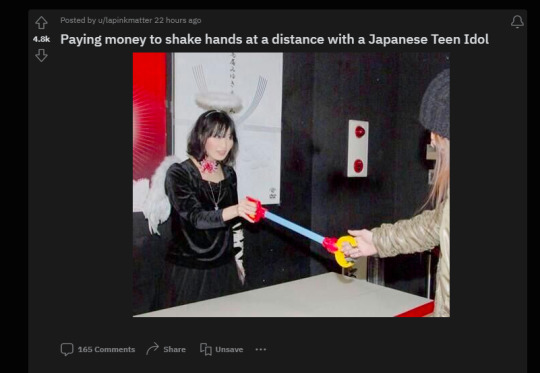
Now, this was posted to mock people who would pay money to meet a "teen idol (a very corporate Japanese celebrity)," but not even being able to shake her actual hand. Obviously, there's more to the story here. So, lets delve deeper.
Initially reading the comments on that post, many users speculate that this is because of increasingly creepy fans doing gross things. Mostly, the comments repeat their laments for how creepy and gross people can be.
So, to double check, and doing a reverse google image search, we find an article that almost confirms those suspicions.
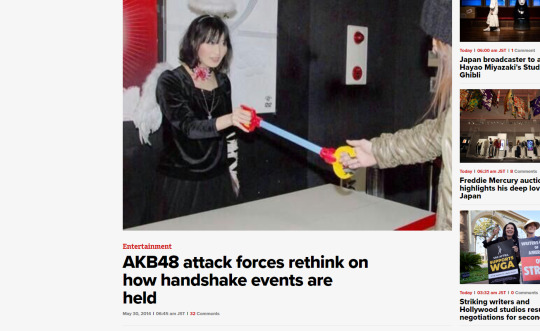
With the search, the only English article I could find was from JapanToday. In their article, they claim that the teen idol band AKB48 had to start taking further precautions for their handshake-centric meet and greets due to a fan pulling out a foldable saw and attacking the girls.
Well, that's pretty morbid. But still, I am skeptical of the image, and it still isn't sourced or labeled. No need to check the validity of JapanToday (I did anyway, not to much avail) as they cite their source at the bottom,

An original author, Asahi Shimbun. Awesome, so lets plug that in and see where it takes us!
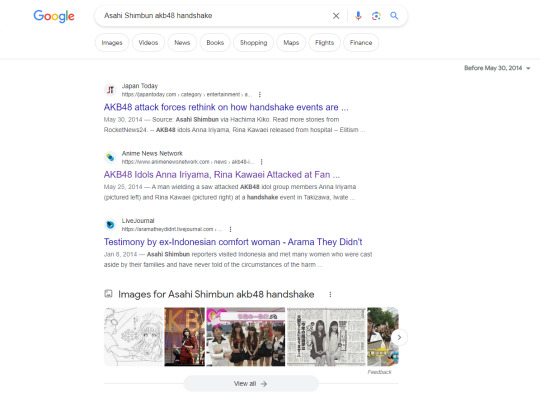
Almost nowhere. I had searched many variations of the above, with no new sources or upstream work to be found. In the mean time, I checked that AKB48 were a real band, and of course they were, so there needed to be more out there about such a crazy story and curious photo.
I finally just searched "Asahi Shimbun akb48" just generally to see if I could find any English articles on either subject (I should say, doing all of this was made much harder due to the source material being from another country and in another language).
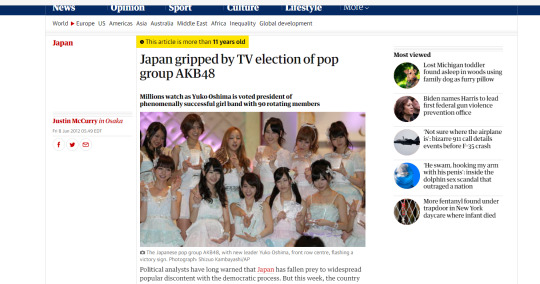
A bit of scrolling, and I was able to find an article by The Guardian about it, and out of anything, they were the most trustworthy source so far. It wasn't really related, but it was the next link, I thought. I looked down to see related articles, and bam.
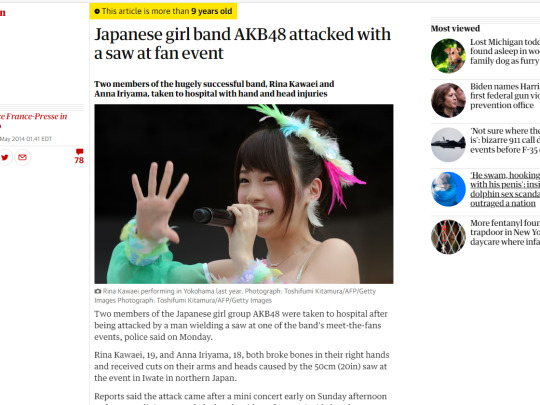
It seemed to be the perfect next step, but still, no mention of a toy claw and revisions to make things safer with distant handshaking.
At this moment, I actually couldn't find anything else, and realized I had to give up on this line of research. I looked up some other things close to this, but nothing further was revealed, and I just found myself on other Reddit posts of the same picture with more speculations told as fact about creepy fans. I'm sure the fans are creepy, I just don't have proof that the lady with the claw arm is related.
I went back to square one and did something I should have done a long time before. I decided to reverse Google image search with the oldest known dates in mind, and went to the first occurrence of the image I could find in a sea of Japanese websites.

It was just that easy. Everything else I was reading was from 2014, and this article from Oricon News was from 2009. It revealed a whole lot, and after translating the website, the true story unfolded.

A really good sign, other pictures from the same event. Supposedly an event held about the release of a new book.
I followed the website's designed path to find out more about the lady in the picture, Miyuki Torii, the author said book.
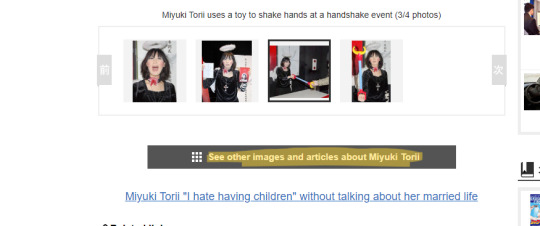
Here, I think was the final thread of information I needed.
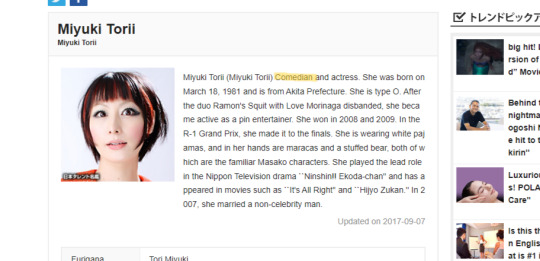
She's a comedian and actress. It was just a book release, and she was being comedic about it. It has nothing to do with teen idols or creepy fans, no new restrictions on distancing herself from people; she just wanted to be goofy with a toy claw, and people on the internet are using the image for many different things.
To verify further, I checked the news source, Oricon News, and as far as I can tell from their public information, they seem legitimate.
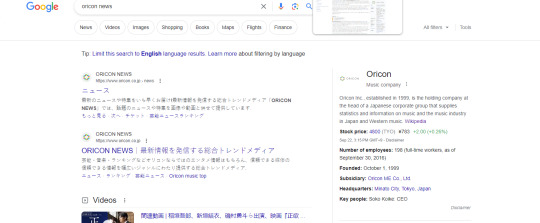
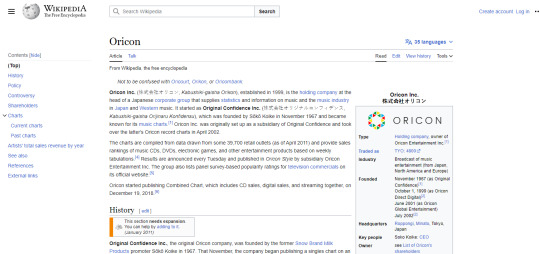
I also further verified by looking up "Miyuki Torii books" and finding ones that matched the images from the event in the photos on the Oricon webpage.
I think this is as far as I could go with this without being pedantic, and I'm satisfied with the result. Totally not what I expected, and ended up being quite different from what was initially being purported.
After putting the couple hours of work in, though, I went back and found the the original Reddit post has a comment now clarifying that it's a comedian, which defeats the purpose of what I just did. They solved it for me before I could type this all out,
but I still enjoyed the journey.
0 notes
Text

Weekly Manga Sekai no Ijin (週刊マンガ世界の偉人) / Asahi Shimbun Publications (朝日新聞出版) / 21st Oct 2012 issue (Featured historical figure: Marie & Pierre Curie)
#educational manga#2010s manga#marie curie#pierre curie#madame curie#asahi shimbun#issue month: october#週刊マンガ世界の偉人#朝日新聞出版
4 notes
·
View notes
Text
Los más extraños, perturbadores y terroríficos… “Junji Ito Maniac: Relatos Japoneses De Lo Macabro”

El genio Junji Itō durante mucho tiempo ha estado a la vanguardia en el mundo del manga de terror japonés.
Con una selección de 20 obras maestras macabras con su visión única de un mundo original y personajes fascinantes dibujados con su impresionante estilo, incluidos títulos populares como “Hanging Balloon” y los personajes favoritos de los fanáticos, Tomie y Soichi, esta serie de anime te sumergirá por completo en el encanto maníaco de Junji Itō.
Estreno: 19 de enero de 2023 en Netflix.
youtube
Basado en las obras de Junji Itō, publicadas en japonés por Asahi Shimbun Publications, el anime está dirigido por Shinobu Tagashira, guionizado por Kaoru Sawada y musicalizado por Yūki Hayashi.




0 notes
Link
Out-of-print publications in South Korea that are now appearing online show that Sun Myung Moon, founder of the Unification Church, regarded himself as a kingmaker and even savior in Japanese politics.
Over about 53 years, a South Korean publishing company compiled Moon’s sayings into 615 volumes until his death in 2012. The sayings are regarded as gospel among church followers.
Although the veracity of Moon’s comments in the online posts cannot be confirmed, a church official said legal action was being considered about the suspected illegal copying of the original volumes.
The church is now officially called the Family Federation for World Peace and Unification.
One comment attributed to Moon in November 1987 complained that Shintaro Abe did not become prime minister.
The previous month, Abe, Noboru Takeshita and Kiichi Miyazawa vied to succeed Yasuhiro Nakasone as president of the ruling Liberal Democratic Party.
But before a party vote, Nakasone intervened and named Takeshita as his successor.
“Abe should have become prime minister,” Moon was quoted as saying on Nov. 1, 1987.
“Nakasone is also someone who was helped by me. The result was flipped over the course of one hour. It was common knowledge that Abe was to become prime minister.”
On Nov. 15, 1987, Moon said: “Anyone who wants to become prime minister in Japan needs my support. Abe should have become prime minister. Shintaro Abe. A written pledge. With whom? That is a secret.”
It is not known what Moon meant by written pledge.
Abe died in 1991, never becoming prime minister.
His son, Shinzo, twice served as Japan’s prime minister. Shinzo Abe’s grandfather, Nobusuke Kishi, was also prime minister.
Moon boasted of his close ties to them as well.
BUILDING CHURCH IN DIET
Moon spoke frequently about strengthening ties with Japanese lawmakers.
On July 4, 1989, he said, “We will build a church in the Diet and teach our principles, making everything possible.”
Moon mentioned Osami Kuboki, the Unification Church’s first chairman in Japan.
“We must increase the number of Diet members, centered on the Abe faction of the LDP, but extending to other parties, based on work led by Kuboki,” Moon said.
He also touched upon the need to increase members elected to local assemblies.
CLOSE TIES TO SHINZO ABE
On Oct. 3, 2006, a week after Shinzo Abe took the office of prime minister for the first time, Moon said, “I understand that Abe became prime minister.”
On Nov. 23, 2006, Moon said: “Shinzo Abe is the prime minister, isn’t he? He is close to me. Shintaro Abe promised to visit South Korea if I made him prime minister.”
Moon’s interest in Japanese politicians dates back to Kishi.
The Unification Church set up its headquarters next door to Kishi’s home in Tokyo’s Shibuya Ward in November 1964. Moon also had close ties with Ryoichi Sasakawa, a well-known right-wing figure.
Moon said he would have Kishi and Sasakawa work together to push forward the Unification Church’s plans in Japan.
FIGHTING JAPANESE BACKLASH
In 1967, parents of university students in Japan who were recruited to join the Unification Church expressed their opposition to what the church was doing.
Twenty years later, lawyers established a national organization to take legal action against the so-called spiritual sales tactics of the Unification Church, which encouraged members to pay exorbitant fees for pots and other religious items.
On Feb. 18, 1988, Moon said: “I knew a typhoon called spiritual sales would hit Japan. We must engage in an international fight. The five major newspapers, including Asahi, Yomiuri and Akahata (the Japanese Communist Party daily), ran special pages.
“Parties from the LDP to JCP and Japan Socialist Party are trying to remove the Unification Church. I fought a battle against such forces by myself.”
HELPED LDP WIN ELECTIONS
Moon often boasted about single-handedly giving the LDP huge victories in national elections.
A Lower and Upper house election was held on the same day in July 1986, and the LDP won in a landslide, picking up 304 seats in the Lower House.
On Feb. 18, 1988, Moon reflected on that result and said: “I was the one who increased the number of Diet members from 261 to 304. There are 180 LDP members who belong to the International Federation for Victory over Communism, (a church-related group).”
He went further about spending 6 billion yen ($45 million at current exchange rates) in the 1986 election and called Unification Church members “well-trained special forces” who go door-to-door to win votes.
Moon kept up the boasts in a comment made on Sept. 16, 2004. “I became involved from the time of Prime Minister Kishi. When Nakasone was prime minister, I helped elect 130 Diet members.”
SAVED KANEMARU FROM ASSASSIN
Moon also referred to his tight ties with another influential LDP politician, Shin Kanemaru, a close associate of Takeshita.
Moon visited Japan on March 26, 1992, and met Kanemaru on March 31.
Moon had served an 18-month prison sentence in the United States for tax evasion.
Ordinarily, people with criminal convictions cannot enter Japan. But the justice minister at the time made an exception for Moon.
Kanemaru told The Asahi Shimbun in April 1992 that he lobbied Justice Ministry officials to allow Moon to enter the nation.
On March 20, 1992, Kanemaru was giving a speech in Tochigi Prefecture when a member of a right-wing group fired three shots at him from close range.
None of the bullets hit Kanemaru.
On April 3, two days after returning to South Korea, Moon said: “Kanemaru invited me to Japan. None of the three bullets fired from 5 meters even hit his body but went somewhere. He was protected by God. I let him live because it would not do to have accidents between Japan and Asia if I did not meet with him.”
KOREA REUNIFICATION PLAN
Masaki Nakamasa, a professor of the history of political philosophy at Kanazawa University, was at one time a member of the Unification Church.
He said he had heard about Moon’s expectations to have Shintaro Abe become prime minister and how he felt betrayed by Nakasone.
Nakamasa said high-ranking church officials in Japan who heard sermons by Moon would pass on those teachings to Japanese members after adjusting discrepancies and toning down radical expressions.
He added that church members were instructed to never take notes about what Moon said or to pass on those comments to outsiders.
“Moon sought to strengthen ties with conservative Japanese politicians to improve the church’s political influence within South Korea so the church could play a leading role in bringing about unification of the two Koreas," Nakamasa said.
#sun myung moon#japanese politics#politics#unification church#unification church in south korea#unification church in japan#kanemaru#Shin Kanemaru#liberal democratic party#1992#ifvoc#international federation for victory over communism#world anti-communist league#right-wing politics#shintaro abe#kishi family#abe family#ffwpu#family federation for world peace and unification
0 notes